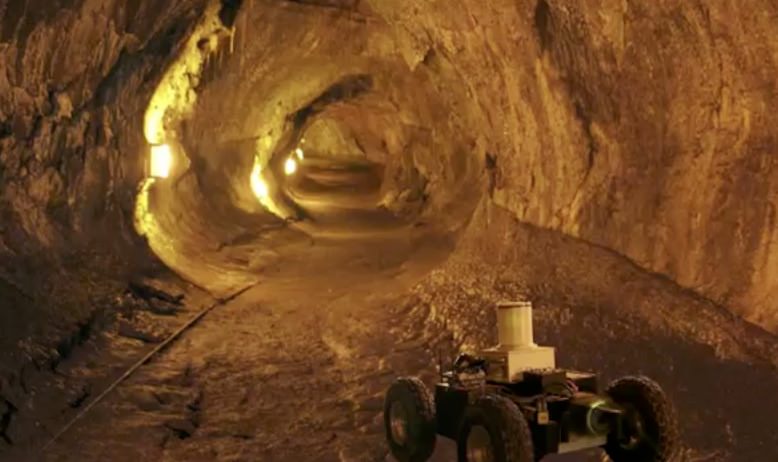Ever since (and most likely long before) the first tantalizing glimpses of a lunar lava tube and skylight were captured by Japan’s Kaguya spacecraft in 2009, scientists have been dreaming of ways to explore inside these geological treasures. Not only would they provide valuable information on the movement of ancient lunar lava flows, but they could also be great places for future human explorers to set up camp and be well-protected from dangerous solar and cosmic radiation.
But before human eyes will ever peer into the darkness of a lava tube on the Moon, robotic rovers will roll along their silent floors — at least, they will if Google Lunar XPRIZE competitor Astrobotic has anything to say about it.
Last month, engineer and Astrobotic CEO Dr. Red Whitttaker talked to NASA about why they want to explore a Moon cave and the history and progress of their project. Check it out below:
“Something so unique about the lava tubes is that they are the one destination that combines the trifecta of science, exploration, and resources.”
– Dr. William “Red” Whittaker, CEO Astrobotic Technology, Inc.
See this and more in-progress Moon plans from various research facilities on the Google Lunar XPRIZE Moon Roundup.
The international Google Lunar XPRIZE aims to create a new “Apollo” moment for a new generation by driving continuous lunar exploration with $40 million in incentive-based prizes. In order to win, a private company must land safely on the surface of the Moon, travel 500 meters above, below, or on the lunar surface, and send back two “Mooncasts” to Earth… all by Dec. 31, 2015.
Astrobotic Technology Inc. is a Pittsburgh-based company that delivers affordable space robotics technology and planetary missions. Spun out of Carnegie Mellon University’s Robotics Institute in 2008, Astrobotic is pioneering affordable planetary access that promises to spark a new era of exploration, science, tourism, resource utilization and mining. (Source)


Don’t forget to give the robots some 8k UHD cameras!
I’d be content with a webcam if they’d just hurry up and get up there.
“they could also be great places for future human explorers to set up camp and be well-protected from dangerous solar and cosmic radiation.”
This is something that needs to be considered for Mars too. Caves can be flooded with atmospheric pressured air, piped in light, and, allow farming / oxygen production. Why build a bunch of structures on the surface, in high radiation areas, and spend millions of $$$, when the cave structures are already there?
We should robot-ship TONS of ScotchGuard in advance, for sealant.
Also protects against meteorids, dust storms and temperature variations. To begin with, maybe stuff could be suspended from the cave ceiling so that the cave (floor) doesn’t even need to be prepared very much. People would only need tents and ropes to camp on… no, in the moon. 😀
But what about the indigenous moon-men? 🙂
I think small mortars should be mounted on the side of the rover? These would be used to launch a web of ‘crater crossing’ grappling hooks, later anchored permanently to suspend high def. camera and instrument platforms and after site selection, lower the rover to the chasm floor….
Apollo 16 did use mortars on the Moon, in a seismic experiment. I like the idea of using explosives in space. I think that it is even more useful there than in construction on Earth because of its reliability and low weight compared to mechanical equipment.
I think putting humans in caves on moon in a good solution, but there remains an issue that needs to be addressed. Indeed you are shielded from the solar and cosmic radiation, but you still have to consider the radiation being generated in the cave itself. To my knowledge the caves on Earth typically have high abundance of radon, which in its decay produces radioactive radiation. The studies in Slovenia in the Postonjska cave showed, that in a approximate one hour long tour through the cave a human would receive a radiation dosage that of a one lung x-ray. So it may pose a problem for the long term inhabitants.
I think this problem needs to be looked at, but is easily solvable.
Radon is most dangerous when inhaled (hence the risk of lung cancer). Since there’d be no breathing on the Moon, in tubes or otherwise, explorers should be reasonably safe from that danger. If anything, pumped vents to the surface could be constructed.
I… just…five days ago…. you guys must be psychic!